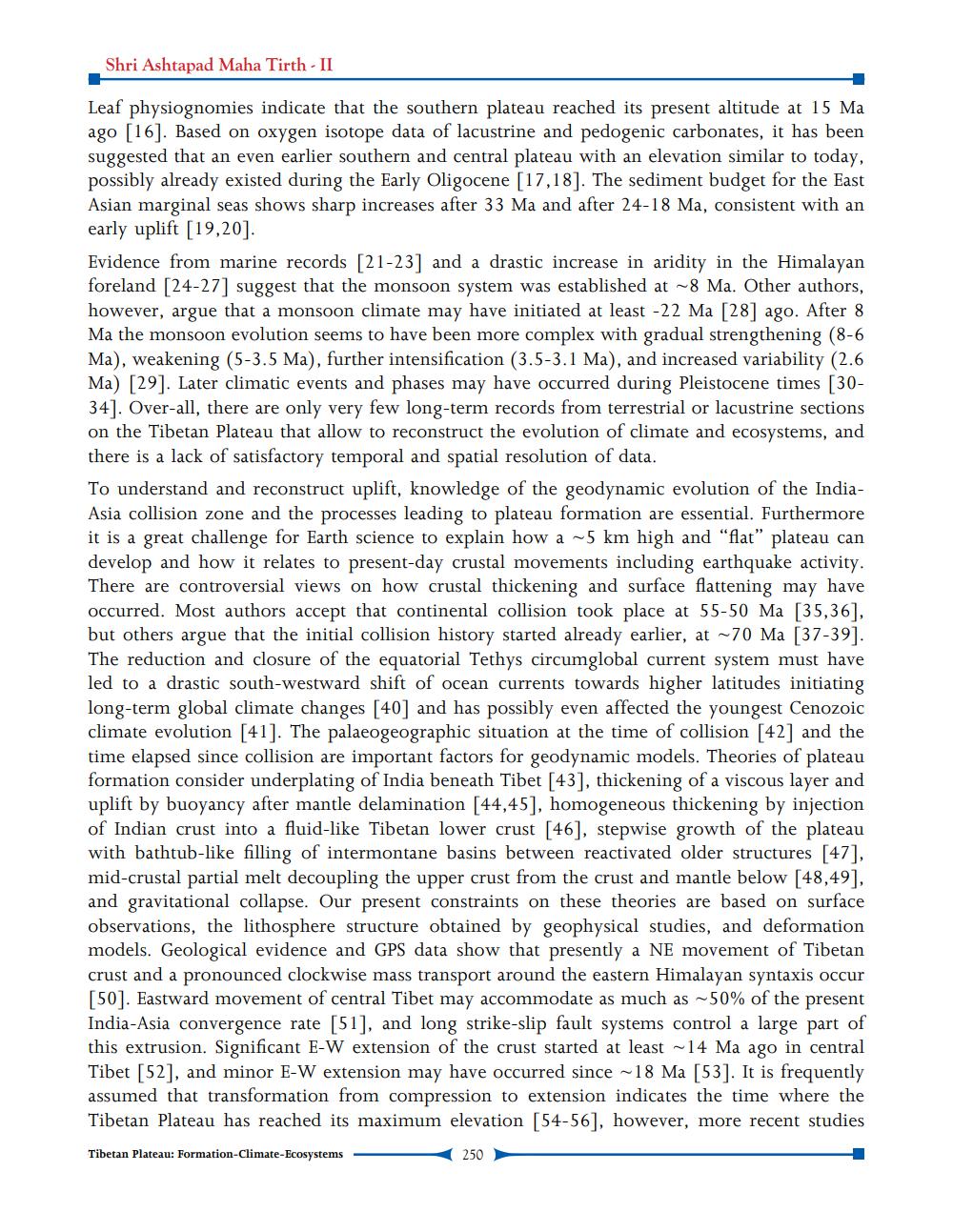________________
Shri Ashtapad Maha Tirth - II
Leaf physiognomies indicate that the southern plateau reached its present altitude at 15 Ma ago [16]. Based on oxygen isotope data of lacustrine and pedogenic carbonates, it has been suggested that an even earlier southern and central plateau with an elevation similar to today, possibly already existed during the Early Oligocene [17,18]. The sediment budget for the East Asian marginal seas shows sharp increases after 33 Ma and after 24-18 Ma, consistent with an early uplift [19,20]. Evidence from marine records [21-23] and a drastic increase in aridity in the Himalayan foreland [24-27] suggest that the monsoon system was established at ~8 Ma. Other authors, however, argue that a monsoon climate may have initiated at least -22 Ma [28] ago. After 8 Ma the monsoon evolution seems to have been more complex with gradual strengthening (8-6 Ma), weakening (5-3.5 Ma), further intensification (3.5-3.1 Ma), and increased variability (2.6 Ma) [29]. Later climatic events and phases may have occurred during Pleistocene times [3034]. Over-all, there are only very few long-term records from terrestrial or lacustrine sections on the Tibetan Plateau that allow to reconstruct the evolution of climate and ecosystems, and there is a lack of satisfactory temporal and spatial resolution of data. To understand and reconstruct uplift, knowledge of the geodynamic evolution of the IndiaAsia collision zone and the processes leading to plateau formation are essential. Furthermore it is a great challenge for Earth science to explain how a ~5 km high and "flat" plateau can develop and how it relates to present-day crustal movements including earthquake activity. There are controversial views on how crustal thickening and surface flattening may have occurred. Most authors accept that continental collision took place at 55-50 Ma [35,36], but others argue that the initial collision history started already earlier, at ~70 Ma (37-39]. The reduction and closure of the equatorial Tethys circumglobal current system must have led to a drastic south-westward shift of ocean currents towards higher latitudes initiating long-term global climate changes [40] and has possibly even affected the youngest Cenozoic climate evolution [41]. The palaeogeographic situation at the time of collision [42] and the time elapsed since collision are important factors for geodynamic models. Theories of plateau formation consider underplating of India beneath Tibet [43], thickening of a viscous layer and uplift by buoyancy after mantle delamination [44,45], homogeneous thickening by injection of Indian crust into a fluid-like Tibetan lower crust [46], stepwise growth of the plateau with bathtub-like filling of intermontane basins between reactivated older structures [47], mid-crustal partial melt decoupling the upper crust from the crust and mantle below [48,49], and gravitational collapse. Our present constraints on these theories are based on surface observations, the lithosphere structure obtained by geophysical studies, and deformation models. Geological evidence and GPS data show that presently a NE movement of Tibetan crust and a pronounced clockwise mass transport around the eastern Himalayan syntaxis occur [50]. Eastward movement of central Tibet may accommodate as much as 50% of the present India-Asia convergence rate [51], and long strike-slip fault systems control a large part of this extrusion. Significant E-W extension of the crust started at least ~14 Ma ago in central Tibet [52], and minor E-W extension may have occurred since ~18 Ma [53]. It is frequently assumed that transformation from compression to extension indicates the time where the Tibetan Plateau has reached its maximum elevation [54-56], however, more recent studies Tibetan Plateau: Formation-Climate-Ecosystems
250




